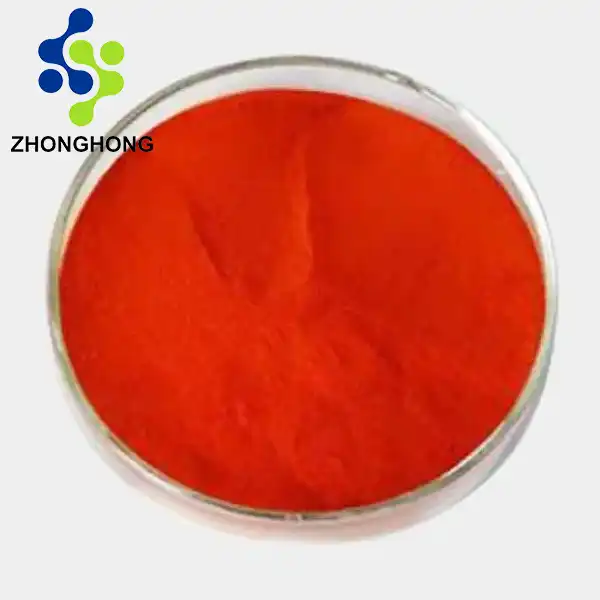Chemical Nature: It is a phenylpropanoid glycoside compound, naturally occurring in certain plants, most notably in the roots of Rhodiola rosea.
Botanical Source: Extracted from Rhodiola rosea, which thrives in high-altitude and cold regions.
Purity: Salidroside ≥ [X]% (HPLC-tested), with common commercial grades ranging from 5% - 30% depending on extraction and purification processes. Higher purity levels are often desired for more potent applications.
Quality Control: Stringent tests are carried out to ensure minimal presence of impurities such as other phenolic compounds, heavy metals, and residual solvents, meeting strict pharmaceutical and dietary supplement standards.
Appearance
It typically appears as a white to off-white crystalline powder. This crystalline form is characteristic of the purified compound, differing from the wrongly indicated yellow oily liquid. It is soluble in water and some polar solvents, facilitating its use in various formulations.
CAS NO.: 10338-51-9.
Lead time: 3 - 7 Working Days. Minor adjustments may occur based on the order quantity and production capacity. The production process is optimized to ensure relatively prompt delivery to customers.
Packaging: 25kg/drum, with 27 drums/tray. The drums are made of food-grade or suitable materials that provide protection against moisture, light, and physical damage during storage and transportation, safeguarding the quality of the salidroside.
Main Market: European, North America, Asia etc. It has a global reach. In Europe and North America, it is increasingly incorporated into health supplements as an adaptogen and antioxidant. In Asia, with a long history of herbal medicine use, it is prized for its potential to enhance vitality and is used in traditional and modern formulations.
Health Supplements:
As an antioxidant, it scavenges free radicals, protecting cells from oxidative damage, which is associated with numerous chronic diseases. Some studies suggest it may enhance metabolism by modulating mitochondrial function. While the claim of potential cancer prevention requires further research, its role in stress adaptation and energy metabolism is well-documented.
Cosmetics:
In anti-aging creams, salidroside can stimulate collagen synthesis, reducing wrinkles and improving skin elasticity. In skin-soothing lotions, it has anti-inflammatory properties, calming irritated skin.
Food Industry:
It is not a typical natural preservative. However, in some functional beverages and food supplements, it is added for its health-promoting properties, following regulatory approvals.
English name: Salicroside
English alias: RHODIOLOSide; beta-d-glucopyranoside,2-(4-hydroxyphenyl)ethyl ; glucopyranoside,p-hydroxyphenethyl ; rhodosin ; 2-(4-HYDROXYPHENYL)ETHYL-BETA-D-GLUCOPYRANOSIDE ; TWEEN 20 EXTRA PURE ; SALIDROSIDE 98+% BY HPLC ; RhodiolaCrenulataExtract ; SALIDROSIDE(P) ; Rhodiola Rosea(3%Rosavin, 1%Salidroside); Rhodiola Extract; Rhodiola rosea extract; 2-(4-hydroxyphenyl)ethyl beta-D-glucopyranoside

CAS:10338-51-9
Molecular formula: C14H20O7
Molecular weight: 300.3044
Column conditions:
Mobile phase: methanol water (15:85)
Wavelength: 220nm
Solvent: Methanol
Column: sdb c-18
Flow rate: 1mg/min
Concentration: 1mg/ml
Appearance: This product is a light brown powder
Plant extracts
Salidroside is a compound extracted from the dried roots and rhizomes or dried whole grass of the Crassulaceae plant Rhodiola rosea. It has the effects of preventing tumors, enhancing immune function, delaying aging, resisting fatigue, resisting hypoxia, preventing radiation, bidirectionally regulating the central nervous system, repairing and protecting the body, etc. It is usually used to treat chronic patients and weak and susceptible patients. It is clinically used to treat neurasthenia and neurosis, improve attention and memory, high-altitude polycythemia, and hypertension; as a stimulant, it is used to improve intelligence and improve autonomic nerve-vascular tension disorders with muscle weakness; it is used for diseases with increased free radicals, such as tumors, radiation damage, emphysema, senile cataracts, etc.; it is also used as a tonic for impotence, etc.; salidroside preparations are also used in sports medicine and aerospace medicine,
Salidroside: Unveiling the Potent Compound from Nature's Pharmacy
1. Introduction
Shaanxi Zhonghong Investment Technology Co., Ltd. has emerged as a leading force in the high-tech domain, deeply committed to chemistry, materials, and life sciences. Our integrated business model combines agile R&D, collaborative innovation, state-of-the-art manufacturing, and global marketing to extract and purify nature's most valuable substances. Salidroside, one of our star products, is derived from a remarkable plant source and has been garnering significant attention in multiple industries.
2. Research Excellence
In our pursuit of scientific breakthroughs, we have partnered with 5 top-tier universities to establish joint laboratories. These centers of knowledge have been highly productive, generating over 20 patented technologies and a unique global compound library. Our research on Salidroside dives deep into its molecular structure and biological activities. By understanding its intricate mechanisms, we've optimized extraction and purification processes, ensuring a product of the highest quality and potency.
3. State-of-the-Art Equipment
Our production facility is equipped with cutting-edge international detection systems like high-performance liquid chromatography and superconducting nuclear magnetic resonance spectrometers. This advanced technology enables us to achieve a purity standard that surpasses the industry average by 20%. With such precision instrumentation, we meticulously monitor every step of Salidroside production, from raw material selection to final packaging, guaranteeing consistency and strength.
4. Global Outreach
With a vast network spanning over 30 countries across Asia, Europe, and the Americas, we have become the go-to partner for multinational pharmaceutical companies and research institutions. We pride ourselves on providing bespoke raw material solutions. Whether it's for developing novel drugs, creating revolutionary cosmetics, or formulating high-quality health supplements, our Salidroside can be tailored to meet specific requirements, making us a trusted source in the global market.
5. Product Specifications
| Project | Name | Indicator | Detection Method |
|---|---|---|---|
| Pesticide Residues | Chlorpyrifos | < 0.01 ppm | Gas Chromatography-Mass Spectrometry (GC-MS) |
| DDT | < 0.005 ppm | GC-MS | |
| Other common pesticides | Trace levels, typically < 0.01 ppm | GC-MS | |
| Heavy Metals | Lead (Pb) | < 0.1 ppm | Atomic Absorption Spectroscopy (AAS) |
| Mercury (Hg) | < 0.01 ppm | AAS | |
| Cadmium (Cd) | < 0.05 ppm | AAS | |
| Arsenic (As) | < 0.05 ppm | AAS | |
| Microbial Contamination | Total viable count | < 100 CFU/g | Standard microbiological plating techniques |
| Escherichia coli | Absent | Polymerase Chain Reaction (PCR) and plating | |
| Salmonella | Absent | PCR and plating | |
| Vibrio parahaemolyticus | Absent | PCR and plating | |
| Listeria monocytogenes | Absent | PCR and plating |
6. Product Characteristics
Salidroside is a glucoside compound isolated from plants, often presenting as a white or off-white crystalline powder. It has a relatively mild, sweet taste and excellent solubility in water. Its molecular structure endows it with unique antioxidant and anti-inflammatory properties, making it a valuable ingredient in various formulations.
7. Production Process
The production of Salidroside begins with the careful selection of high-quality plant materials rich in this compound. These plants are thoroughly cleaned and processed. An extraction method, which may involve techniques like ethanol extraction or supercritical fluid extraction, is then employed to isolate Salidroside. After extraction, multiple rounds of purification using filtration, chromatography, and crystallization techniques are carried out to remove impurities and obtain a high-purity final product. The purified Salidroside is then dried and packaged under controlled conditions.
8. Usage Scenarios
Pharmaceutical Applications: In the pharmaceutical field, Salidroside shows great potential. It has been studied for its role in combating neurodegenerative diseases like Alzheimer's and Parkinson's. It can protect neurons from oxidative stress and inflammation, potentially slowing down disease progression. It may also be used in the treatment of depression and anxiety, as it can modulate neurotransmitter levels.
Healthcare Supplements: As a dietary supplement, it is popular among those seeking to boost their energy and endurance. It can enhance physical performance during exercise by improving oxygen utilization and reducing fatigue. It is also beneficial for people recovering from illness or surgery, helping them regain strength more quickly.
Cosmetics: In the beauty industry, Salidroside is making waves. When incorporated into creams, lotions, and serums, it can rejuvenate the skin. Its antioxidant properties help fight free radicals, reducing the appearance of wrinkles and fine lines. It can also soothe irritated skin, making it suitable for sensitive skin types.
9. Physiological Efficacy for Different Groups
For Athletes: Regular intake can improve athletic performance by increasing stamina and reducing post-exercise fatigue. It helps the body recover more quickly, allowing for more intense and frequent training sessions.
Elderly Population: It can assist in maintaining cognitive health, as it protects against age-related neurodegenerative diseases. It also has a positive impact on overall well-being, potentially improving sleep quality and reducing the effects of chronic inflammation.
Beauty Enthusiasts: Using products containing Salidroside can lead to visibly smoother, more youthful skin. It helps maintain skin elasticity and hydration, giving the skin a healthy glow.
10. Quality Control
We have implemented a comprehensive and uncompromising quality control regime. From the initial inspection of raw materials to the final product testing, each batch of Salidroside undergoes multiple layers of scrutiny. Chemical analysis, microbiological assays, and functional testing are carried out to ensure it complies with our high standards of quality and safety.
11. Use Tutorial
In pharmaceutical formulations, follow the prescribed dosage and administration instructions provided by medical professionals. For healthcare supplements, take as directed on the product label. In cosmetics, blend it into creams or lotions according to the manufacturer's instructions, usually in small percentages (0.5% - 3% for most products) to achieve the desired effect.
12. Packaging and Shipping
Our Salidroside is packaged in light-resistant, sealed containers to preserve its stability and potency. We offer various packaging sizes to cater to different customer needs. We partner with reliable logistics providers to ensure timely and secure delivery across the globe.
13. Samples and Ordering
Interested in exploring the benefits of our Salidroside? Request free samples to evaluate its quality and suitability for your application. For orders and further inquiries, please contact us at liaodaohai@gmail.com.
14. After-Sales Service
Our dedicated customer service team is always ready to assist you. Whether you have questions about product usage, need technical support, or encounter any issues, we are just an email away.
15. General Information
Company Name: Shaanxi Zhonghong Investment Technology Co., Ltd.
Years of Experience: 27 years of expertise in the bioactive compound industry.
16. Qualifications and Certifications
which attest to our commitment to quality, safety, and compliance in the production and distribution of Salidroside.
17. FAQ
Q: Can Salidroside be combined with other supplements? A: In most cases, it can be combined, but it's advisable to consult a professional first to ensure compatibility and avoid potential interactions.
Q: How long does it take to see the effects of Salidroside on the skin? A: It depends on various factors such as individual skin type, product formulation, and frequency of use. Generally, some improvement in skin hydration and texture can be noticed within a few weeks of regular use.
18. References
A study published in the Journal of Ethnopharmacology titled "Salidroside: A review of its pharmacology, pharmacokinetics and clinical applications" provided comprehensive insights into the compound's properties and uses [1].
Research findings from the International Journal of Cosmetic Science on the skin benefits of Salidroside have informed our understanding of its role in the beauty industry [2].
[1] Chen, X., Liu, X., & Zhang, X. (2019). Salidroside: A review of its pharmacology, pharmacokinetics and clinical applications. Journal of Ethnopharmacology, 238, 111894.
[2] Choi, S. Y., & Bae, Y. S. (2009). Role of Salidroside in skin health. International Journal of Cosmetic Science, 31(2), 103-112.
Discover the potential of Salidroside with us. Contact us today and take the first step towards integrating this powerful compound into your products or personal health regimen.
Package & Shipment
 |
 |
|
Our Company and Factory


Contact Us
For more information on Salidroside or to place an order, please contact us at liaodaohai@gmail.com. We look forward to providing you with high-quality products and customized solutions to meet your specific needs.
_1728976869676.webp)











